
views
- Describe your core values and the life experiences that shaped them. Help your audience understand you and your beliefs.
- Brainstorm ideas and develop an outline. Identify your manifesto's core message and develop it into a thesis statement.
- Explain your perspective to your reader and outline an action plan to achieve your goals. Ensure that your plan is specific and realistic.
Getting Started with Your Manifesto
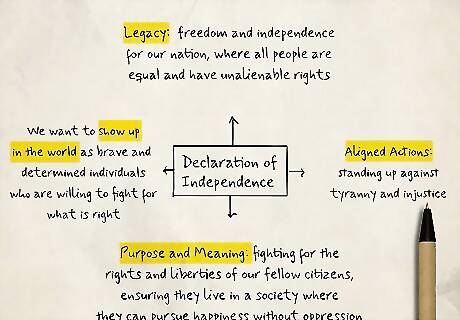
Start with a meaningful question. Your question should inspire you and help focus your writing. You may address multiple questions while writing your manifesto or focus on topics surrounding a single question. Try sample manifesto questions like: What do you want your legacy (as an individual, group, or organization) to be? What gives your life purpose and meaning? What types of actions are aligned with your values? How do you want to show up in the world? What do you want to accomplish in your life? What are you willing to do to achieve those accomplishments?

Brainstorm your ideas. When you're first starting a manifesto, don't feel like you have to know exactly what you'll say. Just write down your ideas in little brainstorming sessions. There are lots of ways to go about brainstorming. Choose one that suits you best and lets you jot down your ideas most freely. Mind maps can help connect many different ideas. Add as many supporting details as possible when writing your mind map. Lists are a great way to get many ideas down quickly. Make a list for each section of your manifesto and title them appropriately. Writing stream-of-consciousness can help you get all your ideas out without worrying about grammar and spelling conventions. Set a time limit and see how much you can write in that time.

Research your topic. Doing research will strengthen your ideas and the evidence you have to support them. Find sources to back up your argument. Read other manifestos to see if anyone has written something similar that can provide you with a model. Familiarize yourself with the theory surrounding your topic. Go to your local library or bookstore and ask a librarian or clerk to help you find similar writers. Read other manifestos on a similar topic for useful tools and arguments. Famous manifestos include The Communist Manifesto by Karl Marx, I Have a Dream by Martin Luther King, and John F Kennedy's Man on the Moon. Strengthen your arguments by reading the opponents of your views online and developing counter arguments.
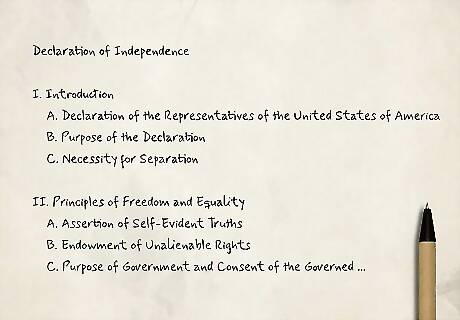
Write an outline. Writing an outline will help you to arrange your ideas once you write. Put them into a logical order. Make sure to include an introduction and a conclusion in your outline. You don't need to write full sentences here. At this point, you're just trying to figure out the flow of your writing. Use Roman numerals to number the major sections. Use uppercase letters to list details about the major sections. Use Arabic numerals (1,2,3) to give specifics or examples about the details of your major sections.
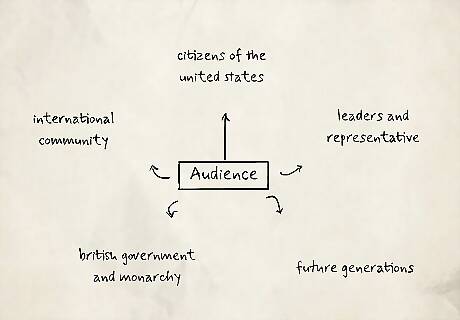
Think about your audience. To whom are you writing the manifesto? Will your work be read by your colleagues, the general public, or clients? This may change how you choose to use language. A theological manifesto might have a lot of academic terminology if your audience is academics, but it might use very plain speech if directed at a wider audience. Avoid using overly complicated language unless you’re writing for an academic audience. Long or complex words may alienate people who would otherwise appreciate your message.
Writing the Introduction to Your Manifesto
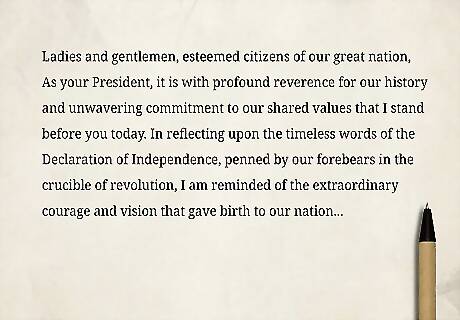
Identify yourself and your aims. State who you are and what your background is. Include information about where you’re from as well as your academic and professional history. Explain your personal beliefs, worldview, and the experiences you’ve had that brought you to this manifesto. By introducing yourself, your readers will better understand your life course. Make sure that you share life details related to your ideas. Relate important experiences from work, school, or life that help readers see you as an authority. Mentioning your degree in art might be useful in an artist's manifesto, just as civil service would be worth mentioning in a political manifesto.
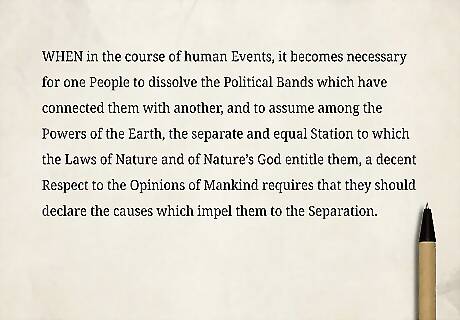
Include a thesis. Identify your core values or message. When writing your thesis statement, you want to clearly convey your manifesto's most important points or principles. The thesis should pose a compelling argument that connects all the other ideas that appear in the body of the manifesto. In The Communist Manifesto, for instance, the thesis centered around the authors’ belief that communism would make for a better system than capitalism. From this core thesis, authors Karl Marx and Friedrich Engels developed the rest of their supporting arguments and evidence.
Writing the Body of Your Manifesto

Elaborate on your ideas individually. Devote a section to each of your main points, even in a short manifesto. This organization will make your points more concrete and understandable for readers. It will also address any questions your readers might have. Give each precept its own paragraph. For longer sections, use a subheading.
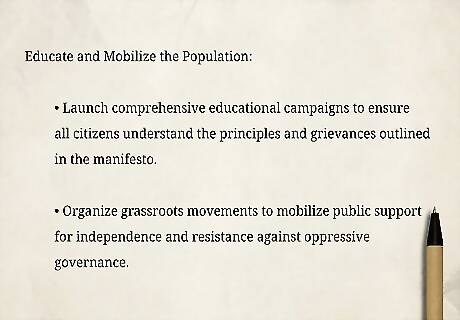
Present an action plan. Offer a direction for change in addition to sharing your ideas and beliefs. Take a current problem and re-imagine it changed through your ideology. Make sure that your goals are realistic and achievable. You should be able to name the actionable steps to achieve your mission. Use concrete details, avoiding words like "thing" and "something:" e.g. "Something in our political system disturbs me" –> "Negligence in our political system disturbs me." Focus on verbs to evoke a sense of action, avoiding verbs like "am/is/are” and “have/has:" "Every artist manifests Art itself" → "Every artist is Art itself." Manifestos are revolutionary by nature. Though not all revolutions are equal in scale, they all share a desire for change.
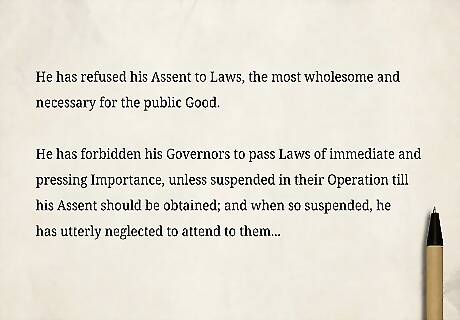
Be concise and engaging. Stick to the points that are most relevant to your thesis. Avoid adding unnecessary details or including all your ideas for improving the target of your manifesto. Keep the reader’s interest by using metaphors, alliteration, and relevant analogies.
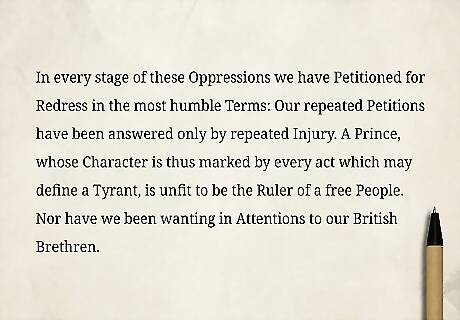
Finish with a conclusion. By writing an effective conclusion, you can remind your readers about what they've read and the main point of your manifesto. Restate your thesis at some point during your conclusion. Give your readers a sense of closure and hope for a path forward—if they follow your action plan and ideologies.
Revising Your Manifesto

Revise the overall structure of your manifesto. Rethink the structure and make sure the paragraph order is logical and flows nicely. Elaborate in any areas where your ideas could be clearer. Cut out anything that’s unnecessary or doesn’t contribute to your main point. By revising your work, you take your rough draft and turn it into something that is better developed and tailored to its purpose. Don't worry about all the little things in this phase. What you want to do is to make big-picture changes.

Edit your manifesto for language, flow, and accuracy. Make sure each sentence connects smoothly to the following one, and restructure sentences as needed. Double-check the accuracy of all the factual information you share. Use stronger language and rewrite sentences in the active voice. Read your manifesto out loud to catch more awkward phrasing or unclear ideas. When you read your work out loud, you're more likely to catch some of these errors you missed.

Ask someone you trust or respect to read your manifesto. A second opinion can give you a new perspective on how you present your ideas. Discussing your manifesto with someone else can also help you to develop stronger ideas and more specific articulations of your aims.

Proofread your manifesto. Look for grammatical and spelling errors you made while writing. Errors can make your work look less credible. Perform this final revision once you're sure you won't be making any more big changes. Proofreading will be the last stage of your editing process.



















Comments
0 comment